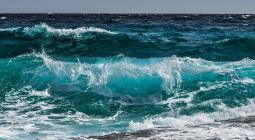Unlocking the potential of Ocean Energy: from megawatts to gigawatts.

When you consider the expanse of the world’s oceans no one should be surprised that the theoretical potential for electricity generated from ocean energy is several times total global energy demand. Of course, that potential needs to be harnessed at commercial prices. Francisco Boshell, Roland Roesch, Alessandra Salgado and Judit Hecke at IRENA run through the technologies used to extract energy from tides and waves, the potential near-term capacity, and pathways to make costs competitive. Although costs are high today – €0.47/kWh or more – continued advancements could see the LCOE drop to under €0.15/kWh by 2030. Innovative business models that combine generation with aquaculture, desalination and other income streams may be needed too. It’s very early days, with installed capacity across all ocean energy technologies a modest 535 MW today. They note that European companies are global leaders in ocean energy technologies, with ambitions to deliver 100GW and 400,000 jobs by 2050. They draw particular attention to the opportunity for small island nations, where water is everywhere, land is scarce, and imported fuel is expensive.
Covering 70% of the planet’s surface, oceans are a source of abundant renewable energy potential. Energy harnessed from oceans, through offshore renewables, can contribute to the decarbonisation of the power sector and other end user applications relevant for a blue economy, e.g. shipping, cooling, water desalination. For countries with coastal areas and island territories, offshore renewables can provide significant socio-economic opportunities, such as job creation, improved livelihoods, local value chains and enhanced synergies between blue economy actors.
Offshore renewables include offshore wind (fixed and floating foundations), ocean energy (wave, tidal, ocean thermal energy conversion/OTEC, salinity gradient) and floating solar PV technologies.
Offshore wind systems have gained more traction in the last decade, and IRENA foresees a promising outlook growing almost ten-fold from 28 GW in 2019 to around 230 GW of global cumulative installed capacity by 2030. Floating PV is an emerging technology following a rapid growth, with already 1.1 GW installed in 2018. The bulk of installations are in fresh water artificial reservoirs; however, the technology is starting to be tested on seawater.
Wind power and solar PV are mature technologies, now moving from onshore to offshore locations. Those technologies benefit from an advanced learning curve due to years of commercial operation in inland applications, combined with the existing experience and capabilities from the offshore oil and gas industry. However, the case of ocean energy technologies is different, as they continue to be a technology at a development and demonstration stage.
Theoretical potential: up to 400% of global electricity demand
The theoretical resource potential of ocean energy ranges from 20,000 TWh to 80,000 TWh of electricity generation per year, representing 100% to 400% of the current global demand for electricity. Ocean energy technologies are commonly categorised based on the resource utilised to generate energy. Tidal stream and wave energy converters are the most widely developed technologies across geographies. Other ocean energy technologies that harness energy from the differences in temperature (Ocean Thermal Energy Conversion) and from the differences in salinity (Salinity Gradient) may become increasingly relevant over longer time horizons.
Tidal technology
The theoretical electricity generation potential of tidal energy is the lowest of all OE technologies, at around with 1,200 TWh/yr. This is due to its very location-specific nature as only some countries can really harness this resource. Interestingly, a sub-category of tidal technology, i.e. tidal range, dominates the current cumulative global installed capacity for ocean energy technologies.
Tidal range technology uses the same principles as hydropower. A dam or barrier traps a large body of water brought in by the tides. The difference between the tide height inside and outside the impounded area allows water to be discharged from one side to the other through turbines inside the structure.
Tidal range has a 98% share of global installed tidal capacity at present corresponding to mainly two large installations: a 240 MW plant deployed in France in 1966 and a 254 MW plant in the Republic of Korea from 2011. However, tidal range (also known as tidal barrage) poses different deployment challenges, mainly due to the limited site availability and high capital investment and unclear environmental impacts.
This adds to the reason why tidal range has not continued to grow, and tidal energy is now moving towards other tidal technologies, particularly tidal current technologies with horizontal axis turbines. Whereas a few years ago single tidal turbines had the capacity of only 100 kW, turbines of 1.5 MW have now been successfully deployed and many developers are scaling them up further. Currently 10MW of this technology is installed and running with several of them being a first phase of larger tidal current farm projects, the most advanced one being the Meygen project in Scotland. Another roughly 15MW of tidal current technologies are planned to be deployed this year and this number is expected to exceed 2 GW by 2025.
Wave technology
The theoretical potential of wave energy is 29,500 TWh/yr[1] and can mainly be found between 30⁰ and 60⁰ latitude and in deep water (> 40 metres) locations. Wave energy technologies have not seen a convergence towards one type of design, as has happened for other technologies such as wind energy. Roughly ten different technology types are being pursued, including oscillating water column, oscillating bodies and overtopping devices.
In recent years, despite the absence of a clear technology convergence for wave technologies, many deployments are oscillating bodies, particularly of the point absorber type. In this technology, energy is generated from the movement of a buoy caused by all wave directions relative to the base connection. The technology readiness level (TRL) of wave energy is lower than that of tidal and its deployment is currently restricted to demonstration and pilot projects, with roughly 2.3 MW installed globally. However, like tidal turbines also wave energy devices are rapidly increasing in size and power output and up to 10 MW could be installed within the next 2 years.
Very early days
The current global cumulative installed capacity across all ocean energy technologies is 535 MW. As previously mentioned, most of this installed capacity (522 MW) corresponds to a few tidal range projects. Excluding those two projects, the global ocean energy cumulative installed capacity sums up to just around 13.2 MW as of today.

Projections for ocean energy deployment
Based on data collected by IRENA, some encouraging developments can be observed for ocean energy. Firstly, reviewing the projects announced to start operation in 2020, they add up to 24 MW of additional capacity. It means that in one year almost twice the total current cumulative capacity (excluding tidal barrage) would be installed. The new added capacity would mainly come from tidal stream and wave technologies.

Looking at the complete pipeline of ocean energy projects to be commissioned in the next 3 to 5 years, IRENA estimates that 3.5 GW of installed capacity would be added if all those tidal stream and wave energy projects are realised. Clearly, the COVID-19 crises will have an impact on the realisation of this projects, but this expected pipeline certainly is an important step forward for the sector, moving from megawatts to gigawatts of installed capacity. The importance is not only in the deployment numbers, but in the opportunity to accelerate the learning curve and the competitiveness for those technologies. Such a growth would also be aligned with IRENA projections of reaching 10 GW of ocean energy deployed worldwide by 2030.

The way forward: reducing the LCOE
A 2019 study from the EU Joint Research Centre (JRC) estimates that the LCOE for tidal stream technologies ranges between 0.47 and 1.02 EUR/kWh, and for wave energy between 0.47 EUR/kWh and 1.4 EUR/kWh. It is expected that continued technology development and advancements in the learning curve may reduce the LCOE to a range between 0.10 and 0.15 EUR/kWh by 2030. Ocean energy would be an interesting option in, for example, remote island territories with high electricity prices due to imported diesel (0.20 to 0.50 EUR/kWh).
However, to bridge the cost gap two key elements are needed: policy incentives and innovative business models. On the policy incentives front, some countries and the European Union provide fiscal incentives and R&D grants to renewable energy projects, including ocean energy. But Canada, specifically the province of Nova Scotia, is the only country that has implemented a Developmental Tidal Feed-in Tariff programme. The Developmental Tidal FiT is specifically for instream tidal device projects. Projects with installed capacity larger than 500 kW can apply to the scheme, to receive a tariff of 0.53 CAD/kWh.
Concerning innovative business models, ocean energy projects are looking into coupling the production of electricity with other renewable energy technologies and economic activities such as aquaculture, sea water cooling or water desalination. This approach results in additional revenue streams for ocean energy projects in addition to selling kWh.

Policy implications
In view of the challenges to meet the policy objectives linked to the UN Sustainable Development Goals, ocean energy should not be seen as a standalone technology but rather as a holistic solution that adds value to industries and communities in coastal areas and island territories.
Today, European companies are clear global leaders in ocean energy technologies, accounting for 66% of tidal energy patents and 44% of wave energy patents globally. Ocean Energy Europe (OEE) considers that the industry can deliver 100GW and create 400,000 jobs In Europe by 2050. This leadership is now backed up by the ongoing preparation of a European Offshore Energy Strategy, to be launched in autumn this year. In this context of Small Island Developing States (SIDS), ocean energy provides a particularly promising market due to their high reliance on other offshore sectors such as fishing, their abundancies of ocean resources, the scarcity of available land and the high electricity costs.
It is hence advisable to include ocean energy in COVID-19 stimulus and recovery packages, fostering a global blue economy. IRENA has been working closely with its member countries to support the uptake of offshore renewable technologies. Organised discussion platforms in Europe and North America, and a Ministerial meeting at its last Assembly in Abu Dhabi. Member countries requested IRENA to facilitate targeted collaboration to accelerate the uptake of offshore renewables and foster a global blue economy. Together with governments, IRENA is working to establish an Offshore Renewables Collaborative Framework. It aims at involving other key stakeholders in offshore renewables and beyond, to advance as a global hub for international collaboration.
3 June 2020
energypost.eu




